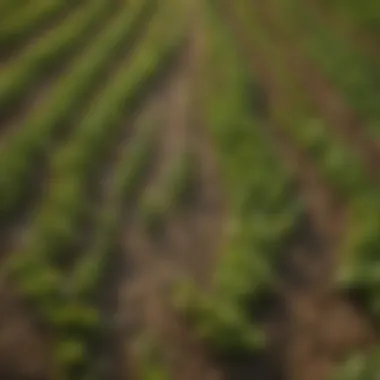Optimal Cover Crops for Enhanced Nitrogen Fixation


Intro
The significance of nitrogen fixation in agriculture is widely recognized among professionals in the field. Cover crops play a vital role in enhancing nitrogen levels in the soil, which are crucial for plant growth. The choice of appropriate cover crops can lead to better soil health, increased crop yields, and sustainable farming practices. This narrative explores how to select the optimal cover crop for nitrogen fixation, highlighting essential concepts that farmers and enthusiasts should consider.
Overview of the Topic
Definition and Importance
Nitrogen fixation refers to the process where atmospheric nitrogen is converted into a form usable by plants. This conversion is primarily achieved by legumes, which possess symbiotic relationships with nitrogen-fixing bacteria. The use of cover crops for nitrogen fixation is significant because they improve soil structure, enhance biodiversity, and reduce the need for synthetic fertilizers. By integrating cover crops into their rotation, farmers can cultivate a more sustainable agricultural system.
Current Trends
Currently, there is a growing interest in sustainable agriculture that promotes ecological balance. More farmers are turning to cover crops to improve soil fertility and support the ecosystem. Research is ongoing into which specific varieties of cover crops yield the best nitrogen results in various conditions. Additionally, sustainable farming practices are being promoted by agricultural organizations and governments worldwide, highlighting the interconnectedness of crop choices and environmental health.
Key Techniques and Practices
Step-by-Step Guide
- Identify Nitrogen Needs: Understand the nitrogen requirements of your primary crops.
- Choose Suitable Cover Crops: Look for species such as clover, vetch, and peas that are known for their nitrogen-fixing ability.
- Evaluate Soil Conditions: Analyze the soil's pH, texture, and moisture levels, which can influence the performance of cover crops.
- Plan Planting Time: Select the right season for planting cover crops, considering local climate and your main crop rotation.
- Integrate Management Practices: Ensure that cover crops are well-managed to optimize their benefits, including appropriate termination before planting main crops.
Tools and Equipment Needed
- Soil Testing Kits: To assess nitrogen levels and other soil parameters.
- Seeders or Drills: To facilitate the even planting of cover crops.
- Mowers or Rollers: For managing the growth of cover crops when they need to be terminated.
Challenges and Solutions
Common Obstacles
Farmers may face challenges such as:
- Invasive Weeds: Cover crops can sometimes harbor weeds, which compete with main crops.
- Unpredictable Weather: Unfavorable conditions can affect the growth and effectiveness of cover crops.
- Limited Knowledge: There might be a lack of information on the best species for specific regions or soil types.
Innovative Solutions
To address these challenges, farmers can:
- Employ Integrated Pest Management: This helps keep weeds under control without solely relying on chemicals.
- Utilize Local Research Data: Rely on studies conducted by local agricultural extension services to select appropriate cover crops.
- Network with Peers: Join online platforms like reddit.com or local farming communities to exchange knowledge and experience.
Incorporating cover crops into farming practices not only enhances soil health but also contributes to a sustainable agricultural future.
Understanding Nitrogen's Role in Agriculture
Nitrogen is a fundamental nutrient in agriculture, vital for healthy plant growth and sustainable crop production. It plays a central role in various physiological and biochemical processes, including the synthesis of proteins, nucleic acids, and chlorophyll. As a component of amino acids, nitrogen is crucial for the formation of plant tissues and enzymes.
Significance of Nitrogen in Soil
Modern agriculture heavily relies on nitrogen, primarily because it influences crop yield and quality. Fertile soil typically holds significant nitrogen levels, which support plant vitality. Farmers understand that sustaining soil nitrogen not only promotes crop health but also supports the broader ecosystem, including soil microbial activity.
- Nitrogen enhances plant growth.
- It improves the structural integrity of crops.
- Nitrogen contributes to higher crop yields.
The Importance of Nitrogen
Nitrogen is essential for optimal plant development. It is one of the key macronutrients that crops need. Farmers often rely on fertilizers to enhance nitrogen levels, as natural soil nitrogen can diminish over time due to continuous cropping and leaching. This has led to a cycle of dependency on synthetic fertilizers, which are convenient but can lead to environmental pollution and health concerns.
One of the most significant prevailing issues is nitrogen leaching into waterways, causing eutrophication. This phenomenon can lead to harmful algal blooms, severely impacting aquatic life. By managing nitrogen levels effectively, farmers not only improve their yields but also protect their local environment. Strategies such as cover cropping can enhance the cycling of nitrogen within agricultural systems.
Nitrogen Deficiency Symptoms in Crops
Recognizing nitrogen deficiency in crops is crucial for timely intervention. Symptoms often manifest as yellowing leaves, particularly in the older foliage. This is due to the lack of chlorophyll, which is essential for photosynthesis. Other indicators include stunted growth and poor overall vigor of the plant.
If farmers observe these signs, it is essential to act swiftly. Here are some common symptoms to watch for:
- Chlorosis: Light green or yellow leaves indicate nitrogen deficiency.
- Stunted Growth: Plants may not reach expected heights or yield.
- Poor Flowering: In flowering crops, reduced nitrogen can lead to fewer flowers or fruits.
Tracking these symptoms can help farmers make informed decisions about nitrogen management. A balanced approach, including the use of cover crops, can mitigate nutrient deficiencies while enriching soil health.
What Are Cover Crops?
Cover crops play a significant role in sustainable agriculture. Understanding them is essential for farmers or anyone interested in maintaining soil health, increasing soil fertility, and improving overall crop yields. This section defines cover crops, discusses their purpose, and describes different types.
Definition and Purpose
Cover crops are primarily grown to improve soil quality rather than for direct harvest. Their main role is to cover the soil, which helps to prevent erosion and nutrient loss. Cover crops can capture nutrients, increase organic matter, and promote soil biodiversity.
Farmers utilize cover crops to enhance nitrogen levels through biological processes. When planted, these crops grow quickly, forming biomass that can be incorporated into the soil. This process not only adds organic matter to the soil but also provides habitat for beneficial organisms. Therefore, the purpose of cover crops extends beyond simple soil coverage; they actively contribute to long-term soil health and ecological balance.
Types of Cover Crops
Different types of cover crops can be selected based on specific goals and local conditions. The two main categories for categorization are leguminous and non-leguminous cover crops. Understanding these types helps determine what might work best for enhancing nitrogen fixation.
- Leguminous Cover Crops: These include crops such as clover, vetch, and peas. They have the ability to fix nitrogen from the atmosphere through a symbiotic relationship with bacteria. This makes them particularly valuable for replenishing soil nitrogen levels.
- Non-Leguminous Cover Crops: Examples include cereal rye, buckwheat, and radishes. While they do not fix nitrogen, they still provide several benefits such as weed suppression, erosion control, and improving soil structure.
Farmers may choose a combination of these types to achieve their goals. The choice largely depends on factors like regional climate, soil type, and primary crops grown. Selecting the right cover crop is vital for maximizing benefits and contributing to the overall success of the farming operation.
Mechanisms of Nitrogen Fixation
Understanding the mechanisms of nitrogen fixation is essential for farmers and agronomists looking to enhance soil fertility sustainably. Nitrogen fixation refers to the process by which atmospheric nitrogen is converted into a form that plants can use. This has significant benefits for agricultural systems, including reducing the need for synthetic fertilizers, improving soil health, and promoting biodiversity.


Biological Nitrogen Fixation Processes
Biological nitrogen fixation is primarily carried out by certain types of bacteria. These bacteria possess the unique capability to convert atmospheric nitrogen (N₂) into ammonia (NH₃). This conversion is fundamental because most plants cannot utilize N₂ directly. The ammonia produced can then be incorporated into amino acids and other metabolites vital for plant growth.
The process typically occurs in two main forms:
- Free-living bacteria: These bacteria, like Azotobacter and Clostridium, exist in the soil and do not require a host plant to fix nitrogen.
- Symbiotic bacteria: Rhizobia are the best-known symbiotic nitrogen-fixing bacteria. They form partnerships with legumes, developing nodules on the roots of these plants, where they convert nitrogen into ammonia. This relationship is not just beneficial for the bacteria but also for the legume, enabling it to access essential nutrients in nutrient-poor conditions.
The benefits of biological nitrogen fixation include:
- Reduced dependence on chemical fertilizers, leading to decreased production costs and environmental impact.
- Enhancement of soil organic matter, promoting better soil structure and moisture retention.
- Support of microbial diversity in the soil ecosystem, fostering a more resilient agricultural system.
Symbiotic Relationships
Symbiotic relationships between plants and nitrogen-fixing bacteria are often the most effective mechanism of nitrogen addition to soils. Leguminous plants, such as clover or soybeans, establish a symbiotic relationship with specific rhizobia species. In this setup, the plant provides carbohydrates and a protective environment for the bacteria, while the bacteria supply the plant with usable nitrogen.
The significance of these symbiotic relationships lies in their efficiency and sustainability. Factors influencing the success of these interactions include:
- Plant selection: Choosing the right legume species optimized for particular soil types and climate conditions increases the likelihood of successful nitrogen fixation.
- Soil health: Nutrient-rich and well-aerated soils support robust root development, enhancing the effectiveness of nitrogen-fixing bacteria.
- Management practices: Crop rotation and proper timing of sowing can enhance the benefits derived from these symbiotic relationships.
In summary
Nitrogen fixation plays a fundamental role in sustainable agriculture. By understanding the mechanisms of biological nitrogen fixation and leveraging the symbiotic relationships between legumes and bacteria, farmers can improve soil fertility, reduce input costs, and promote environmental stewardship.
"Implementing cover crops with effective nitrogen-fixing abilities can pivotally shift farming practices toward sustainability."
Focusing on these processes allows for a more informed decision-making framework regarding cover crop selection and overall farm management.
Evaluating Cover Crop Species for Nitrogen
Evaluating cover crop species for nitrogen fixation is crucial for mitigating nitrogen deficiencies in soils. This section outlines the importance of selecting the right types to maximize nitrogen benefits and enhance soil health. Cover crops can improve soil structure, reduce erosion, and enhance biodiversity. Moreover, understanding which crops to select reflects a farmer's commitment to sustainable practices.
Leguminous Cover Crops
Common Types
Leguminous cover crops include species such as clover, vetch, and peas. These plants are known for their ability to fix atmospheric nitrogen through a symbiotic relationship with specific bacteria. This makes them a popular choice among farmers aiming to enrich their soils naturally.
Key Characteristics of Common Types:
Leguminous crops are crucial because they can significantly increase nitrogen availability in the soil. The unique feature of these crops is their nitrogen-fixing nodules, formed in the roots, which convert nitrogen from the atmosphere into a form usable by plants. This characteristic makes legumes a beneficial option, especially in nitrogen-deficient soils.
Advantages and Disadvantages:
While legumes are highly effective in improving soil nitrogen levels, they also require specific conditions to thrive. For instance, some species may struggle in poorly drained soils or under certain climatic conditions. Understanding these factors is key for effective crop selection.
Growth Characteristics
The growth characteristics of leguminous cover crops can vary widely among species. Growth rate, biomass production, and root depth are essential aspects that determine their nitrogen-fixing potential.
Key Characteristics of Growth Patterns:
Certain legumes, like hairy vetch, display rapid growth and can establish a dense mat of vegetation. This not only provides ground cover but also enhances biomass, which contributes to soil organic matter when decomposed. This growth characteristic is beneficial in reducing soil erosion and suppressing weeds.
Unique Features, Advantages, and Disadvantages:
However, the quick growth sometimes leads to competition for nutrients with subsequent crops. Farmers must monitor growth to ensure that legumes do not hinder the performance of cash crops.
Non-Leguminous Cover Crops
An Overview
Non-leguminous cover crops, like sorghum sudangrass and buckwheat, pose another alternative for nitrogen management. Although they do not fix nitrogen, they can improve soil health and structure through deep root systems.
Key Characteristics of An Overview:
Non-leguminous crops can be exceptionally effective in enhancing soil quality. They often have high biomass, which contributes to organic matter and promotes biodiversity in the soil. Several farmers are adopting these crops to enhance ecosystem performance as part of their rotational strategies.
Unique Features, Advantages, and Disadvantages:
One limitation of non-leguminous crops is that they do not fix nitrogen directly. Therefore, they should be used in combination with leguminous crops or as part of a comprehensive nutrient management plan to achieve optimal results.
Pros and Cons
When examining the pros and cons of using non-leguminous cover crops, several factors come into play.
Key Characteristics of Pros and Cons:
The advantage includes improved soil aeration, water retention, and pest suppression, which contribute to overall crop productivity. They can also help control weeds effectively with their vigorous growth patterns.
Unique Features, Advantages, and Disadvantages:
On the downside, the lack of nitrogen fixation means farmers must rely on alternative sources of nitrogen, such as fertilizers, to achieve optimal crop yields. Balancing the use of non-leguminous cover crops in farming systems is crucial for sustainable agricultural practices.
"Integrating various cover crops based on their properties can lead to enhanced nitrogen levels and improved soil health overall."
In summary, evaluating cover crop species for nitrogen fixation involves understanding the distinct roles of both leguminous and non-leguminous options. Each category offers unique benefits and challenges, making it important for farmers to tailor their choices to their specific soil and climate conditions. This ensures that the selected cover crops will effectively contribute to nitrogen management and overall soil fertility.
Key Characteristics of Ideal Nitrogen-Fixing Cover Crops
Identifying the ideal nitrogen-fixing cover crop involves understanding specific characteristics that enhance nitrogen availability in the soil. These attributes help ensure that the cover crop serves its primary functions effectively—boosting soil fertility and improving agricultural productivity.
Growth Rate and Density
The growth rate and density of a cover crop are crucial factors affecting its nitrogen-fixing capabilities. Fast-growing species can quickly cover the soil, reducing erosion and weed competition. Additionally, high-density plantings maximize biomass, which contributes to organic matter in the soil.
- Fast Establishment: Rapid growth can be especially important in short growing seasons. Crops like Clover and Vetch can establish quickly and outcompete weeds, promoting healthy soil.
- Optimal Plant Spacing: Dense plantings reduce sunlight penetration to the soil, which can inhibit weed growth. Defining proper spacing can optimize yields and nitrogen fixation rates.
- Biomass Production: Higher biomass ultimately leads to more decomposition, which enhances nutrient cycling. Cover crops with substantial above-ground and below-ground growth can significantly contribute to soil nitrogen levels.
Root System Development
Root systems play an equally vital role in the effectiveness of nitrogen-fixing cover crops. The depth, structure, and health of the root systems help plant species access nutrients and water.


- Deep Roots: Crops like Radish have deep taproots that can break up compacted soil layers. This allows better water infiltration and nutrient absorption, creating a more favorable environment for other plants.
- Root Nodules: Many legumes develop symbiotic relationships with bacteria in their root nodules, significantly increasing their nitrogen-fixing abilities. This means species such as Soybeans and Peas can effectively convert atmospheric nitrogen into a plant-available form.
- Soil Structure Improvement: A well-developed root system enhances soil structure. Strong roots stabilize the soil and increase porosity, which improves water retention and nutrient exchange.
"The key to enhancing soil fertility lies not only in the crop species used but also in their growth habits and root functionality."
These characteristics collectively guide farmers toward selecting the appropriate species for their agricultural systems. A careful assessment of the growth rate and root systems ensures that cover crops can effectively manage nitrogen, contributing to sustainable farming practices.
Regional Considerations in Cover Crop Selection
Selecting the right cover crop for nitrogen fixation involves taking into account various regional factors that can greatly influence the effectiveness of the chosen species. These factors can range from climate conditions to soil types, and they play a crucial role in determining which cover crops will perform optimally. It is imperative for farmers and enthusiasts to evaluate these regional considerations to enhance nitrogen levels effectively and promote sustainable agricultural practices.
Benefits of Regional Considerations:
- Improves the efficiency of nitrogen fixation processes.
- Enhances crop yield and soil health.
- Minimizes risks associated with crop failure due to unexpected climatic changes.
- Increases the resilience of farming systems against pests and diseases.
Climate Adaptability
Climate is one of the most significant factors influencing cover crop selection. Each crop has different growth requirements relating to temperature, sunlight, and precipitation. Therefore, understanding the local climate helps in choosing species that can thrive under specific conditions.
Key considerations include:
- Temperature Range: Some legumes like hairy vetch perform well in cooler climates, while others, such as cowpeas, prefer warmer temperatures. Farmers should assess the average temperatures in their region to match them with suitable cover crops.
- Precipitation Patterns: In areas with significant rainfall, cover crops should be able to withstand waterlogged conditions, whereas in arid regions, drought-tolerant species are necessary to maintain soil health.
Choosing a cover crop that aligns with the climate reduces stress on the plants and can lead to more robust growth. This consideration not only increases nitrogen fixation potential but also contributes to overall crop resilience.
Soil Type Compatibility
In addition to climate, soil type is a critical factor in the selection process of effective cover crops. Different soils have unique characteristics that can benefit from specific crops that are better adapted to those conditions.
Considerations for soil type include:
- Soil Texture: Sandy soils often require cover crops with deeper root systems, such as deep-rooted legumes, while clay soils may benefit from more fibrous-rooted crops that improve structure.
- Nutrient Content: Knowing the macronutrient and micronutrient status of the soil can help in selecting cover crops that either supplement deficiencies or improve an area’s nutrient holding capacity.
Understanding soil type is not merely academic; it has practical implications. A wrong choice can lead to poor growth and decreased nitrogen levels, undermining the initial purpose of using cover crops.
"The integration of cover crops must be framed within the context of regional specificity to maximize agronomic benefits and ecological integrity."
Integration of Cover Crops into Farming Systems
Integrating cover crops into farming systems is crucial for enhancing soil health and improving agricultural outcomes. Cover crops serve multiple functions that contribute significantly to sustainable farming. The process of integrating these crops is not merely an add-on; it is a strategic move that can redefine the dynamics of nutrient management in agriculture. The objective is to ensure that nitrogen fixation happens in a way that aligns with overall farm goals, thus optimizing inputs and increasing resilience against environmental stressors.
Crop Rotation Strategies
Crop rotation is an effective strategy when considering the inclusion of cover crops. This practice involves alternating different types of crops in the same area over time. Rotating crops can break pest cycles and reduce weed pressure. When cover crops are included in these rotations, they enhance nitrogen levels while also providing other benefits. For example, planting legumes like clover after a cereal crop can improve soil nitrogen availability for the subsequent crop. This method allows for efficient use of resources while maintaining soil fertility.
The timing of planting and termination of cover crops is also essential in crop rotation strategies. Timely planting before the main crops are sown ensures that nutrients from the cover crops are available at the right moment. For farmers, understanding the life cycle of the cover crop varieties can lead to better synergy with main crops.
Intercropping Techniques
Intercropping is another advanced technique for integrating cover crops into farming systems. This method involves growing two or more crops in proximity, but with a primary focus on complementing their growth patterns and functionalities. For instance, intercropping a nitrogen-fixing legume with a cash crop can provide immediate benefits. The legume can improve soil nitrogen while possibly shielding the cash crop from specific pests or diseases.
Farmers need to select species that complement each other effectively. Such choices can lead to a competitive advantage, enhancing overall productivity. Careful management is required to ensure both crops benefit from their relationship without competing heavily for resources like light and nutrients.
"The integration of cover crops through crop rotation and intercropping enriches the soil, improves resilience, and paves the way for sustainable farming practices."
In summary, integrating cover crops into farming systems through crop rotation and intercropping is an informed approach. This process not only enhances nitrogen levels but also contributes to the overall ecological balance of farm ecosystems. It can lead to long-term sustainability and productivity for the farming community.
Economic Considerations
Economic considerations play a pivotal role in the decision-making process for farmers adopting cover crops. Understanding the financial implications not only aids in maximizing yield and soil health but also ensures sustainability in farming operations. Overall, cover crops can present an initial cost but the long-term benefits often outweigh these expenses.
Cost-Benefit Analysis of Cover Crops
Conducting a cost-benefit analysis of cover crops involves a careful examination of potential expenses against projected gains. Farmers need to take into account several factors, including:
- Seed costs: Different cover crop species vary in price. Leguminous crops may have higher seed costs compared to non-leguminous types.
- Establishment expenses: This includes labor and equipment needed for planting. The more intensive the practice, the higher the initial outlay becomes.
- Maintenance: Ongoing care during the crop cycle may add to costs, including weed management and irrigation.
In evaluating the benefits, farmers might consider:
- Soil improvement: Enhanced nitrogen levels can lead to better crop yields in subsequent seasons, reducing the need for chemical fertilizers.
- Erosion control: This can save money on soil replacement and improve long-term land value.
- Pest and disease suppression: Healthier soils and crops lead to lower costs associated with pest management.
Ultimately, the analysis must reflect not just the immediate financial outlay, but how these cover crops contribute to the overall agricultural ecosystem and economic viability.
Long-term Financial Benefits
The long-term financial benefits of implementing cover crops are often compelling enough to offset initial investment. Key advantages include:
- Increased soil health: Better soil structure improves water retention and nutrient cycling, thereby reducing reliance on expensive chemical fertilizers over time.
- Enhanced crop productivity: As soils become richer in nitrogen, farmers can witness greater yields, driving up revenue.
- Resilience to climatic variations: Improved soil health means that crops are better equipped to withstand droughts or floods, leading to more consistent yields.
- Higher marketability: Sustainable farming practices are increasingly valued in the market, potentially allowing farmers to command higher prices for their produce.
In summary, while the initial costs of cover crops can be daunting, the advantages accrued over time with increased productivity and improved soil health provide a solid basis for their integration into farming systems.
Challenges of Using Cover Crops
Cover crops serve many ecological and agronomic purposes, including promoting nitrogen fixation. However, embracing cover crops also comes with challenges that farmers and agricultural enthusiasts need to navigate. Barriers can affect economic viability, crop yield, and farm management practices. Understanding these challenges is crucial in making informed decisions that align with long-term agricultural goals.
Potential Pest Issues


Introducing cover crops can inadvertently create a habitat for pests. While some cover crops can deter certain insects, others may attract them. Insects that thrive on specific cover crops can multiply quickly, turning from a beneficial presence into a harmful one.
For instance, certain legumes might attract aphids, which are known for transmitting diseases. Farmers should anticipate this risk and monitor pest populations closely throughout the growing season. Knowledge about local pest dynamics can help guide cover crop selection, minimizing pest-related issues.
Here are some strategies to manage potential pest issues:
- Crop Rotation: Changing the type of cover crops each year can help disrupt pest life cycles.
- Integrated Pest Management (IPM): Use a variety of control methods including biological and chemical options, tailored to specific pests.
- Scout Regularly: Frequent observation can enable early detection of pest populations, allowing for timely intervention.
The aim is to weight the benefits of nitrogen fixation against the potential risks introduced by pests.
Nutrient Competition
Another significant challenge of using cover crops is nutrient competition. While cover crops can enhance soil health, they also compete with cash crops for essential nutrients. This is especially true if the cover crops grow aggressively, potentially depleting nitrogen and other nutrients from the soil.
Farmers must strategize when to plant cover crops to reduce competition with main crops. Timing is key: planting cover crops during off-seasons can mitigate nutrient competition, ensuring that the main crops have access to necessary nutrients during critical growth stages.
Consider the following aspects to manage nutrient competition effectively:
- Selective Timing: Choose cover crops that will not compete during planting and growing seasons of main crops.
- Soil Testing: Conduct regular soil tests to understand nutrient availability. This information can guide nutrient management strategies.
- Appropriate Species Selection: Certain cover crops, like vetch or clover, may be less competitive for nutrients while still effectively fixing nitrogen.
Ultimately, managing nutrient competition is about finding the right balance between maintaining soil health and optimizing crop yields.
As farmers integrate cover crops into their practices, they must thoughtfully address challenges like pest issues and nutrient competition to enhance the benefits of nitrogen fixation in their fields.
Case Studies of Successful Practices
Case studies provide tangible evidence of the effectiveness of cover crops in enhancing nitrogen levels in agricultural systems. By examining real-world examples, farmers can understand the practical applications of theory, leading to informed decisions about which cover crops to adopt.
Such studies not only document the successes but also outline the challenges faced. They highlight how specific management practices and environmental conditions influence the performance of cover crops. Additionally, case studies can reveal innovative strategies that farmers employ, promoting knowledge sharing within the agricultural community. Consequently, farmers can see the real-life benefits of nitrogen-fixing cover crops and ascertain their adaptability to various conditions.
Farm A: A Legume-Focused Approach
Farm A exemplifies the effective use of leguminous cover crops. Known for their ability to fix atmospheric nitrogen through symbiotic relationships with specific bacteria in their root nodules, legumes such as common bean and red clover have offered significant improvements in soil health. Farmers here focus on rotating these crops with cash crops like corn and soybeans.
One notable aspect of Farm A's practice is its careful selection of legume species. For example, using crimson clover has helped establish a dense ground cover that suppresses weeds while contributing nitrogen back into the soil. Farmers at this location keep track of soil tests, showing notable increases in available nitrogen after using cover crops.
The experience of Farm A also highlights the importance of management practices. Farmers emphasize timely planting and termination of cover crops to maximize benefits. They adopt no-till methods to reduce soil disturbance, which helps maintain soil structure and organic matter.
Farm B: Innovative Non-Legume Strategies
Farm B represents an alternative approach by utilizing non-leguminous cover crops. While often overlooked for nitrogen fixation, specific non-leguminous options like sorghum-sudangrass have proven effective at preventing nitrogen leaching and enhancing organic matter in the soil. This practice addresses not only the nitrogen needs but also improves overall soil structure.
At Farm B, farmers create a diverse cover crop mix. For instance, pairing sorghum-sudangrass with oats allows for nutrient cycling and reduces competition among the plants. Farmers report greater resilience of their cash crops due to improved soil quality and water retention.
In addition to these benefits, Farm B recognizes some specific challenges, such as the potential for nutrient competition and pest attraction, which they manage through regular monitoring and adjusting. Their innovative application of non-leguminous cover crops emphasizes the need for broader consideration beyond legumes.
"These case studies demonstrate that both leguminous and non-leguminous cover crops can effectively enhance nitrogen levels, each offering unique benefits and challenges that farmers must navigate.”
Through thorough examination of different farming approaches, these case studies enrich the knowledge base regarding optimal cover crops for nitrogen fixation. They serve as a resource for farmers looking to tailor their practices to maximize soil health, showcasing viable methods and strategies in increasing nitrogen efficiency.
Future Trends in Cover Crops for Nitrogen Management
The landscape of agriculture is shifting, influenced by environmental concerns and the need for sustainable practices. Finding the right cover crops for nitrogen management is particularly relevant today. This section will outline emerging trends, research developments, and technological advancements that advance the practice of using cover crops effectively.
Research Developments
Recent research efforts focus on understanding the complex relationships between cover crops and soil health. Scientists are investigating how different species contribute to nitrogen fixation and overall soil fertility. For instance, studies comparing various leguminous plants like clover and pea have provided insights about their nitrogen contributions and growth conditions.
Researchers are also exploring plant varieties with enhanced nitrogen-fixing abilities. Breeding programs aim to develop crops that can maintain or improve nitrogen levels even under stress. The identification of specific microbial interactions in the rhizosphere is of particular interest. These microbes can play a significant role in enhancing the efficiency of nitrogen fixation. Thus, comprehensive research can pave the way for practical applications in farming.
- Understanding plant-microbe symbiosis.
- Exploring the genetic modification of cover crops.
- Expanding databases on cover crop performance in different soil conditions.
Adoption of Technology
Technological advancements play a crucial role in optimizing cover crop management. Precision agriculture tools offer farmers new ways to monitor and manage cover crops, ensuring they meet the nitrogen needs of the soil. Using drones for aerial imaging enables farmers to assess crop health and nitrogen levels over large areas efficiently.
Moreover, soil sensors can provide real-time data on nutrient status, informing decisions about which cover crops to plant and when to incorporate them. The integration of technology in cover cropping can significantly enhance its potential, allowing for more strategic planning and management.
Key technologies to consider include:
- Soil moisture sensors to monitor conditions more accurately.
- Data analytics platforms for refining planting schedules.
- Remote sensing technologies to evaluate cover crop efficiency at a larger scale.
Properly implemented, technology can transform cover crop management into an efficient practice, maximizing nitrogen benefits.
In summary, both research and technology are guiding the future of cover crops for nitrogen management. By staying current with research developments and adopting these technologies, farmers can ensure better soil health and productivity.
Finale and Recommendations
The conclusion and recommendations section is crucial in this article as it encapsulates the key insights derived from the comprehensive discussion on cover crops and nitrogen fixation. Cover crops play an essential role in enhancing soil health and fertility. Not only do they contribute to nitrogen levels, but they also impact other aspects of soil quality, such as structure, moisture retention, and biodiversity. Understanding the interactions between different cover crop species and their specific environmental requirements will aid farmers in making informed choices that align with their agronomic goals.
Summary of Best Practices
To effectively utilize cover crops for nitrogen fixation, several best practices can be recommended:
- Choose the right species: Selecting the appropriate leguminous or non-leguminous cover crop is vital depending on the local climate and soil type. For instance, clover and vetch are commendable for their nitrogen-fixing capabilities, while rye contributes to soil structure.
- Timing and management: Optimal planting and termination dates should be observed. This ensures that cover crops have adequate growth periods to maximize their benefits.
- Soil testing: Regular testing of soil nutrients can guide the selection of cover crops that address specific deficiencies, allowing for targeted improvements in soil fertility.
- Integration with other practices: Cover crops should be part of a holistic approach. This includes crop rotation, organic amendments, and conservation tillage, which further enhance their effectiveness.
- Monitoring and evaluation: Farmers should monitor the outcomes of cover crop implementation, adapting techniques based on results observed over time.
Future Directions for Research
The realm of cover crops and nitrogen management holds significant potential for continuous research. Future directions could include:
- Genetic improvement: Investigating the genetic traits of cover crop species for enhanced nitrogen-fixing capabilities can lead to more efficient varieties.
- Long-term impacts: More longitudinal studies are needed to assess the long-term effects of various cover crop strategies on soil health and crop yields, providing clearer insights tailored to diverse agricultural systems.
- Technological integration: The adoption of precision agriculture and technology such as drones or remote sensors could improve monitoring of cover crop performance and soil conditions efficiently.
- Diversity and resilience: Researching combinations of cover crops that enhance resilience against pests and diseases can lead to sustainable farming practices.
In summary, the effective use of cover crops for nitrogen fixation requires a strategic approach, grounded in research and best practices. With ongoing advancements in agricultural science, farmers will have increasingly robust tools to retain soil productivity and integrity.



